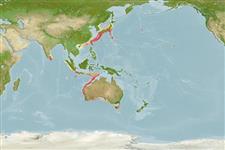>
Eupercaria/misc (Various families in series Eupercaria) >
Cepolidae (Bandfishes) > Owstoniinae
Etymology: Owstonia: Named for Alan Owston (1853‒1915), an amateur naturalist, yachtsman and collector of Asian wildlife, notably fishes from Japan and China.; kamoharai: Named for the late Dr. Toshiji Kamohara (1901-1972) of Kochi University..
Environment: milieu / climate zone / depth range / distribution range
Ekologi
marina; brackvatten bottenlevande; djupintervall 200 - 350 m (Ref. 116607). Subtropical
Indo-West Pacific: off Western Australia and the Arafura Sea.to southern Japan.
Size / Vikt / Age
Maturity: Lm ? range ? - ? cm
Max length : 39.6 cm SL hane/ej könsbestämd; (Ref. 116607); 40.2 cm SL (female)
Life cycle and mating behavior
Maturities | Reproduktion | Spawnings | Egg(s) | Fecundities | Larver
Smith-Vaniz, W.F. and G.D. Johnson, 2016. Hidden diversity in deep-water bandfishes: review of Owstonia with descriptions of twenty-one new species (Teleostei: Cepolidae: Owstoniinae). Zootaxa 4187(1):1-103. (Ref. 119093)
IUCN Red List Status (Ref. 130435)
Threat to humans
Harmless
Human uses
Verktyg
Special reports
Download XML
Internet-källor
Estimates based on models
Phylogenetic diversity index (Ref.
82804): PD
50 = 0.5000 [Uniqueness, from 0.5 = low to 2.0 = high].
Bayesian length-weight: a=0.00389 (0.00180 - 0.00842), b=3.12 (2.94 - 3.30), in cm total length, based on all LWR estimates for this body shape (Ref.
93245).
Trofisk nivå (Ref.
69278): 3.4 ±0.4 se; based on size and trophs of closest relatives
Resiliens (Ref.
120179): Mellan, lägsta populationsfördubblingstid 1,4-4,4 år (Preliminary K or Fecundity.).
Fishing Vulnerability (Ref.
59153): Moderate vulnerability (39 of 100).
